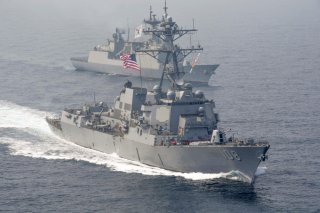Locked In: The Navy Is Laser-Focused on Countering China
The AUKUS agreement reveals how cognizant the United States is of China’s growing clout in the Pacific and Beijing’s increasing willingness to use force to achieve its geopolitical objectives.
Several recent interviews with the Chief of Naval Operations, Adm. Mike Gilday, reveal how the United States is thinking about the challenge posed by China in the Pacific—not alone, but in tandem with partners and allies.
During a conversation with Defense One, Admiral Gilday provided insights into the kind of submarine system Australia will likely receive as part of the AUKUS agreement, the tripartite defense cooperation pact that brings Canberra into the United Kingdom and United States’ cooperative nuclear propulsion technology relationship.
“So, to answer your first question about the type of submarine, we’re still working through that. And so it’s important that the outcomes here – the main outcome is to ensure that Australia gets a submarine capability and eventually the capability to design and build their own—design and build their own submarines,” Admiral Gilday explained. “That’s a long-term effort.”
“There’s also a lot of capability sharing across the three partners,” the Chief of Naval Operations emphasized. “And so one of the benefits that I see in the near term with AUKUS is that it’s helped us focus on what barriers we can knock down with respect to sharing technology and sharing information that we may not have been as agile in doing so before we had this agreement.”
“As you’re probably aware, we’re in a consultive period right now. We’re out until the end of March of ’23. We’ll finally present a recommendation to the secretary of defense and the president that’ll answer those questions with respect to discrete capabilities,” Admiral Gilday said.
“But right now, there’s a number of working groups—there’s double-digit working groups—that are involved right now taking a look at different aspects of the whole ecosystem that has to be in place in order to sustain, operate, maintain, and produce submarines.”
The AUKUS agreement reveals how cognizant the United States is of China’s growing clout in the Pacific and Beijing’s increasing willingness to use force to achieve its geopolitical objectives. By bringing Australia into the nuclear fold, the United States can indirectly increase the amount of significant naval assets it could bring to bear against the Chinese.
In a separate interview with the Heritage Foundation, Admiral Gilday offered insights into the U.S. Navy’s strategic thinking. “And so in order to give us a distributed force, we looked at what type of attributes that force would need in order to be effective in combat. And so we thought about the fact that it needed to it needs to be distributed fleet it needs to be able to come at an adversary like China, across multiple vectors and all domains simultaneously,” Admiral Gilday explained.
“It needs to have the attribute of distance so that's weapons with range and speed that can hold an adversary at bay. We have to have sound defensive systems for fleet survivability. And so that includes our investments in areas like hypersonics, areas like laser technology, and high powered microwave and a defensive role,” he said.
“We had to think about deception, concealment, maneuver, stealth and how we apply those technologies. We had to think about decision advantage and we have a project ongoing that we think will put us in a position to actually move information to the tactical edge faster than we ever have before to put our commanders and our tactical action officers in a position to deliver effects and make decisions faster than their opponent.”
So while China’s challenge to American interest in the Pacific is significant, the U.S. Navy is betting on emerging technologies and the assistance of friends and allies in the region to blunt potential Chinese aggression.
Caleb Larson is a multimedia journalist and defense writer with the National Interest. A graduate of UCLA, he also holds a Master of Public Policy and lives in Berlin. He covers the intersection of conflict, security, and technology, focusing on American foreign policy, European security, and German society for both print and radio. Follow him on Twitter @calebmlarson.
Image: Reuters.

